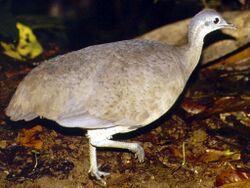Biology:Tinamus
From HandWiki
Short description: Genus of birds
| Tinamus | |
|---|---|

| |
| Great tinamou (Tinamus major) | |
| Scientific classification | |
| Domain: | Eukaryota |
| Kingdom: | Animalia |
| Phylum: | Chordata |
| Class: | Aves |
| Infraclass: | Palaeognathae |
| Order: | Tinamiformes |
| Family: | Tinamidae |
| Subfamily: | Tinaminae |
| Genus: | Tinamus Hermann, 1783 |
| Type species | |
| Tetrao major[1] Gmelin, JF, 1789
| |
| Species | |
|
see text | |
Tinamus is a genus of birds in the tinamou family Tinamidae. This genus comprises some of the larger members of this South American family.
Taxonomy
The genus Tinamus was introduced in 1783 by the French naturalist Johann Hermann.[2] The type species was subsequently designated as the great tinamou.[3][4] Hermann based his name on "Les Tinamous" used by Georges-Louis Leclerc, Comte de Buffon in his Histoire Naturelle des Oiseaux. The word "Tinamú" in the Carib language of French Guiana was used for the tinamous.[5][6]
The genus contains five species:[7][8]
- White-throated tinamou (Tinamus guttatus) – southeastern Colombia, southern Venezuela, Amazonian Brazil, and northern Bolivia
- Grey tinamou (Tinamus tao) – northern and western Brazil, eastern Ecuador, eastern Peru, northern Bolivia, Colombia east of the Andes, northwestern and northeastern Venezuela, and northwestern Guyana
- Solitary tinamou (Tinamus solitarius) – northeastern Argentina (Misiones), eastern Paraguay, eastern Brazil
- Black tinamou (Tinamus osgoodi) – in two small areas: the Andes of southeastern Peru and the Andes of Colombia
- Great tinamou (Tinamus major) – from southeastern Mexico through Panama, excluding Honduras and from Ecuador to French Guiana, parts of Brazil and northern Bolivia
References
- ↑ "Tinamidae". The Trust for Avian Systematics. https://www.aviansystematics.org/4th-edition-checklist?viewfamilies=1.
- ↑ Hermann, Johann (1783). Tabula affinitatum animalium olim academico specimine edita, nunc uberiore commentario illustrata cum annotationibus ad historiam naturalem animalium augendam facientibus. Argentorati [Strasbourg]: Impensis Joh. Georgii Treuttel. pp. 164, 235.
- ↑ Apstein, C. (1915). "Nomina conservanda. Unter Mitwirkung zahlreicher Spezialisten herausgegeben" (in German). Sitzungsberichte der Gesellschaft Naturforschender Freunde zu Berlin 5: 119–202 [197]. https://www.biodiversitylibrary.org/page/43609419.
- ↑ Mayr, Ernst; Cottrell, G. William, eds (1979). Check-List of Birds of the World. 1 (2nd ed.). Cambridge, Massachusetts: Museum of Comparative Zoology. p. 12. https://www.biodiversitylibrary.org/page/16108633.
- ↑ Buffon, Georges-Louis Leclerc de (1778). "Le tinamou cendré" (in French). Histoire Naturelle des Oiseaux. 4. Paris: De l'Imprimerie Royale. p. 502. https://gallica.bnf.fr/ark:/12148/bpt6k10697142/f572.item.
- ↑ Jobling, James A. (2010). The Helm Dictionary of Scientific Bird Names. London: Christopher Helm. p. 386. ISBN 978-1-4081-2501-4. https://archive.org/stream/Helm_Dictionary_of_Scientific_Bird_Names_by_James_A._Jobling#page/n386/mode/1up.
- ↑ Gill, Frank; Donsker, David; Rasmussen, Pamela, eds (January 2022). "Ratites: Ostriches to tinamous". IOC World Bird List Version 12.1. International Ornithologists' Union. https://www.worldbirdnames.org/new/bow/ratites/.
- ↑ Clements, James (2007). The Clements Checklist of the Birds of the World (6 ed.). Ithaca, NY: Cornell University Press. ISBN 978-0-8014-4501-9.
Wikidata ☰ Q368369 entry
 |

